Our military Gun Park has over a dozen exhibits used in coastal defence spanning over 300 years of warfare, as well as a recreation of the Battery Observation Post which would have targeted the guns on Spike Island. It is much loved by military enthusiasts and children alike!
12-pounder SMOOTH-BORE Cannon
 Range: 1,760 yards (1,600 metres)
Range: 1,760 yards (1,600 metres)
Manufacturer: Walker & Company, Sheffield, England
Dates in Service: c1760-1800
This 12-pounder muzzle-loading smooth-bore cannon is the earliest example of the guns that were deployed on Spike Island. It fired grapeshot, shrapnel or a cannonball weighing 12 pounds (5.44kg) up to a range of 1,760 yards (1,600m). To load the cannon, a cartridge of gunpowder, followed by a steel ball and lastly, a wad was rammed down the barrel. To fire the cannon, a flame or flint ignited the charge which detonated the gunpowder forcing the cannonball out of the barrel at great speed. This one and the two outside the main gate were buried vertically on the pier as bollards.
7-inch Rifled Muzzle Loading Cannon
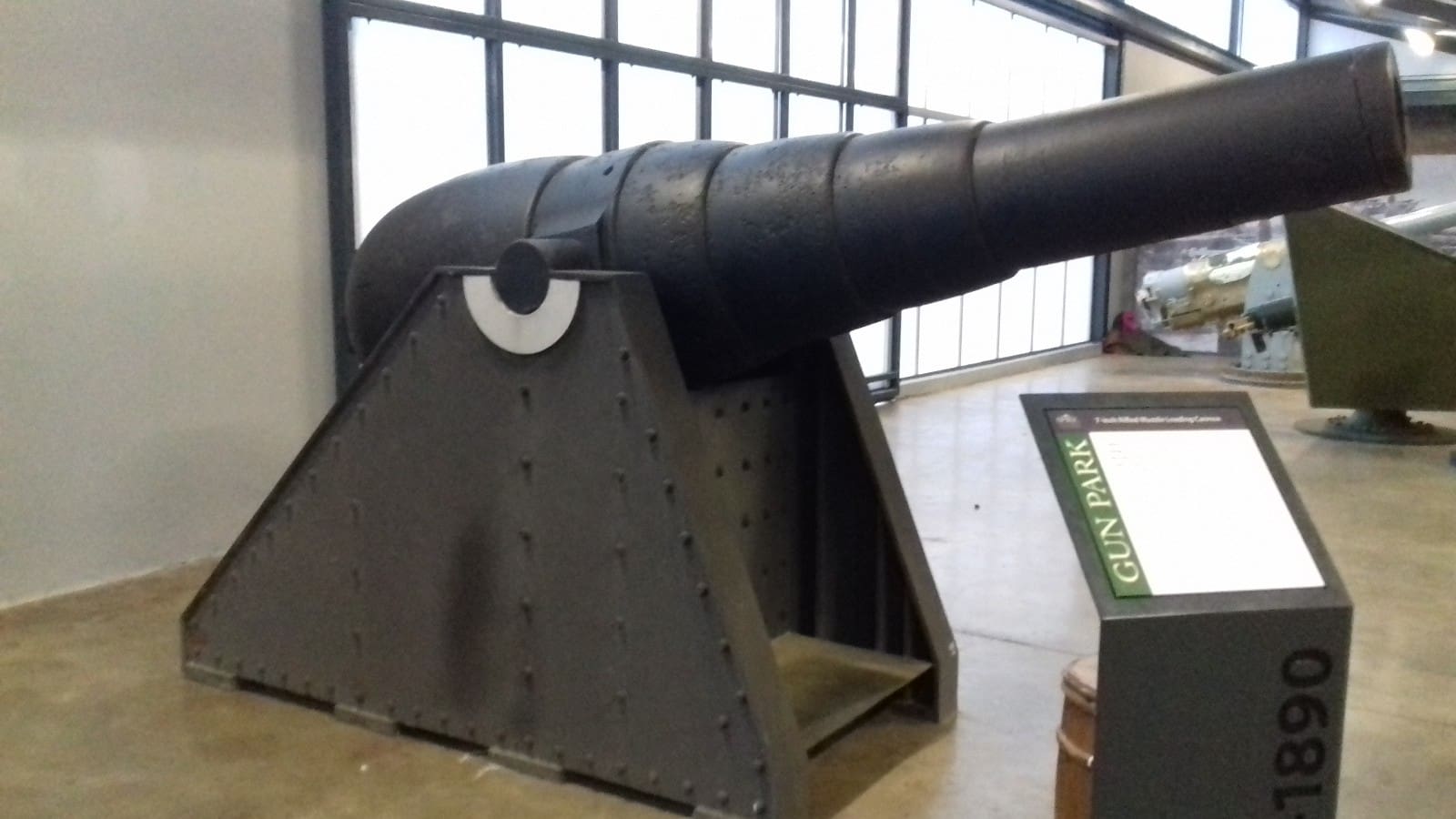
Calibre: 7-inch (180mm)
Range: Up to 2.000 yards (1.830 meters)
Manufacturer: Woolwich Arsenal, England
Dates in Service: 1865-1890
This is an example of one of the earliest rifled cannon. Rifling is the process of cutting spiral grooves into the inside of a gun barrel. Rifling puts a stabilising spin on the projectile as it moves through the barrel thus improving accuracy and range. Three of these 7-inch cannon were deployed on Spike in the mid-1860s, one on each of the bastions facing Cobh. Three 11-inch versions were later deployed on the three bastions facing the harbour entrance.
Battery Observation Post (BOP)
 The Battery Observation Post on Spike Island was the Fire Control Centre for the two 6-inch guns on the island. It was where the essential information of an attacking ship was gathered and processed. This included the ship’s position, range, speed and direction of travel. This data was converted into an elevation and direction for the aiming of the guns together with the correct charge. The charge provided the explosive power to ensure the projectile reached its target. The guns could operate independently when the target was in view and within range of the gun’s auto-sight. The underground Battery Observation Post on No. 3 Bastion is open to visitors.
The Battery Observation Post on Spike Island was the Fire Control Centre for the two 6-inch guns on the island. It was where the essential information of an attacking ship was gathered and processed. This included the ship’s position, range, speed and direction of travel. This data was converted into an elevation and direction for the aiming of the guns together with the correct charge. The charge provided the explosive power to ensure the projectile reached its target. The guns could operate independently when the target was in view and within range of the gun’s auto-sight. The underground Battery Observation Post on No. 3 Bastion is open to visitors.
18-pounder Field Artillery Gun
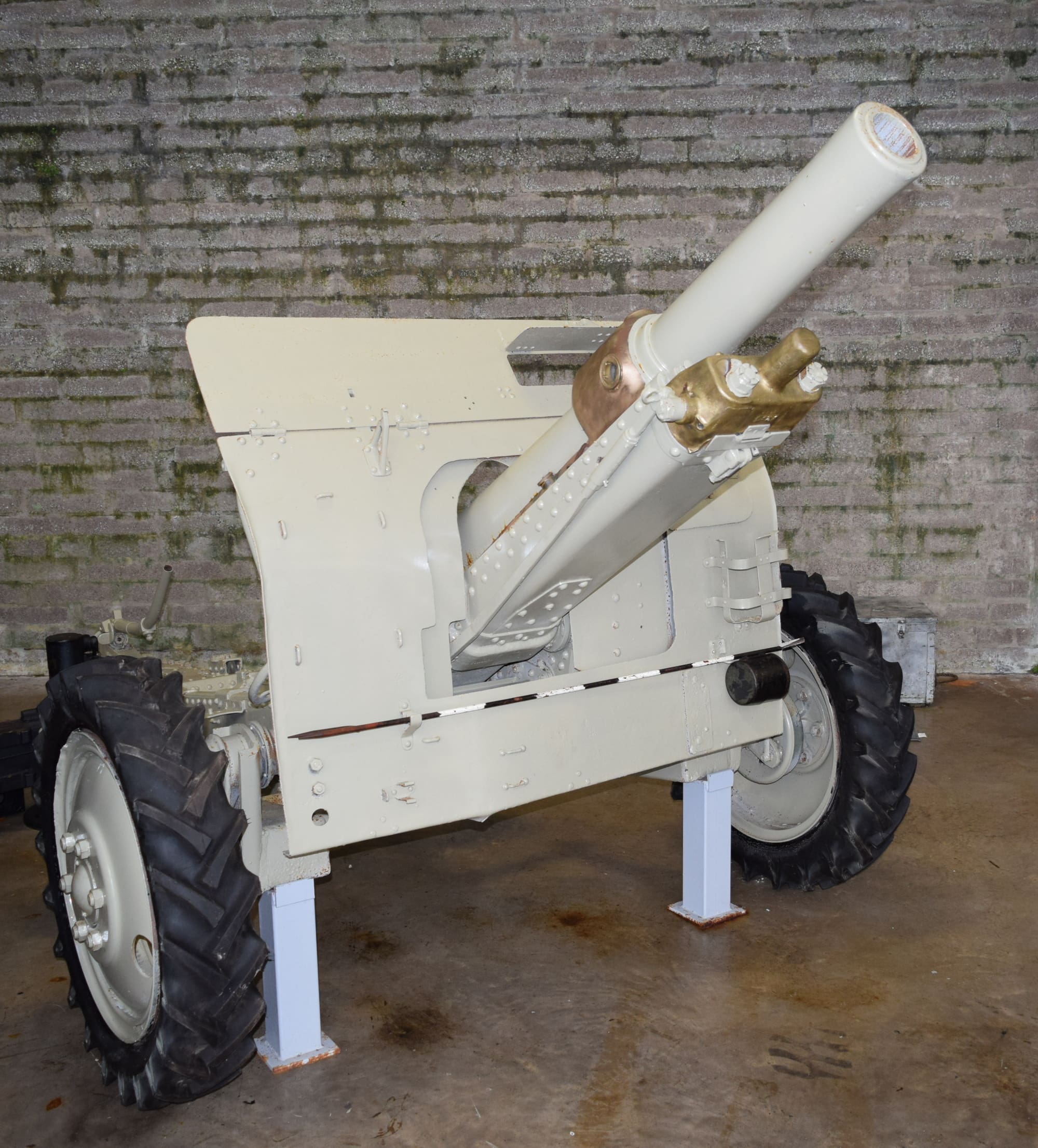 Calibre: 3.3 inch (83.8mm)
Calibre: 3.3 inch (83.8mm)
Range: Up to 6525 yards (5966m)
Manufacturer: Vickers Armstrong, England
The first version of this gun with cartwheels was manufactured in 1904. The QF 18-pounder guns were the first artillery pieces acquired by the Defence Forces in 1922. Initially, on loan from the British, they were purchased the following year. These guns formed the backbone of the new Irish Army Artillery Corps. Steel wheels with pneumatic tyres, as seen here, were fitted during the 1930s. This allowed the guns to be towed by motorised vehicles. The guns were taken out of Irish service in 1974.
4.7-inch QF Gun
 Calibre: 4.7-inch (120 mm)
Calibre: 4.7-inch (120 mm)
Range: Up to 13.123 yards (12.000 meters)
Manufacturer: Elswick Ordnance Company, England
Dates in Irish Sevice: 1938-1947
4.7-inch QF (quick-firing) guns have naval origins dating back to the 1860s and were
adapted for land use in the 1890s. In Ireland, 4.7-inch guns were deployed to Fort Dunree, Co.
Donegal and Reenduff Battery on Bere Island, County Cork. This particular 4.7-inch gun was obtained from Britain by the Irish government circa 1942 for the defence of Galway port. It was never
deployed. Here at Fort Mitchel, there are two of the larger 6-inch guns, now fully restored and on view under No. 2 and No. 4 Bastions.
12-pounder Gun and Shield
 Calibre: 3 inch (76.2mm)
Calibre: 3 inch (76.2mm)
Range: up to 8,000 yards (7,315 metres)
Manufacturer: Elswick Ordnance Company, England
Dates in Service: 1938 – 1947
12 Pdr quick-firing (QF) breech-loading (BL) guns were designed in the 1880s. BL guns are fully operated at the rear and are quicker to load and have greater range and accuracy. The gun shield is extremely rare. During the First World War, these guns were operated at Fort Carlisle (Davis) and Fort Camden (Meagher) to counter motor torpedo boats attack and covering fire for the minefield. Today, four of these guns on No. 3 Bastion are used for ceremonial purposes by the Defence Forces as the Cork Harbour Saluting Battery.
Defensive Electric Light (DEL)
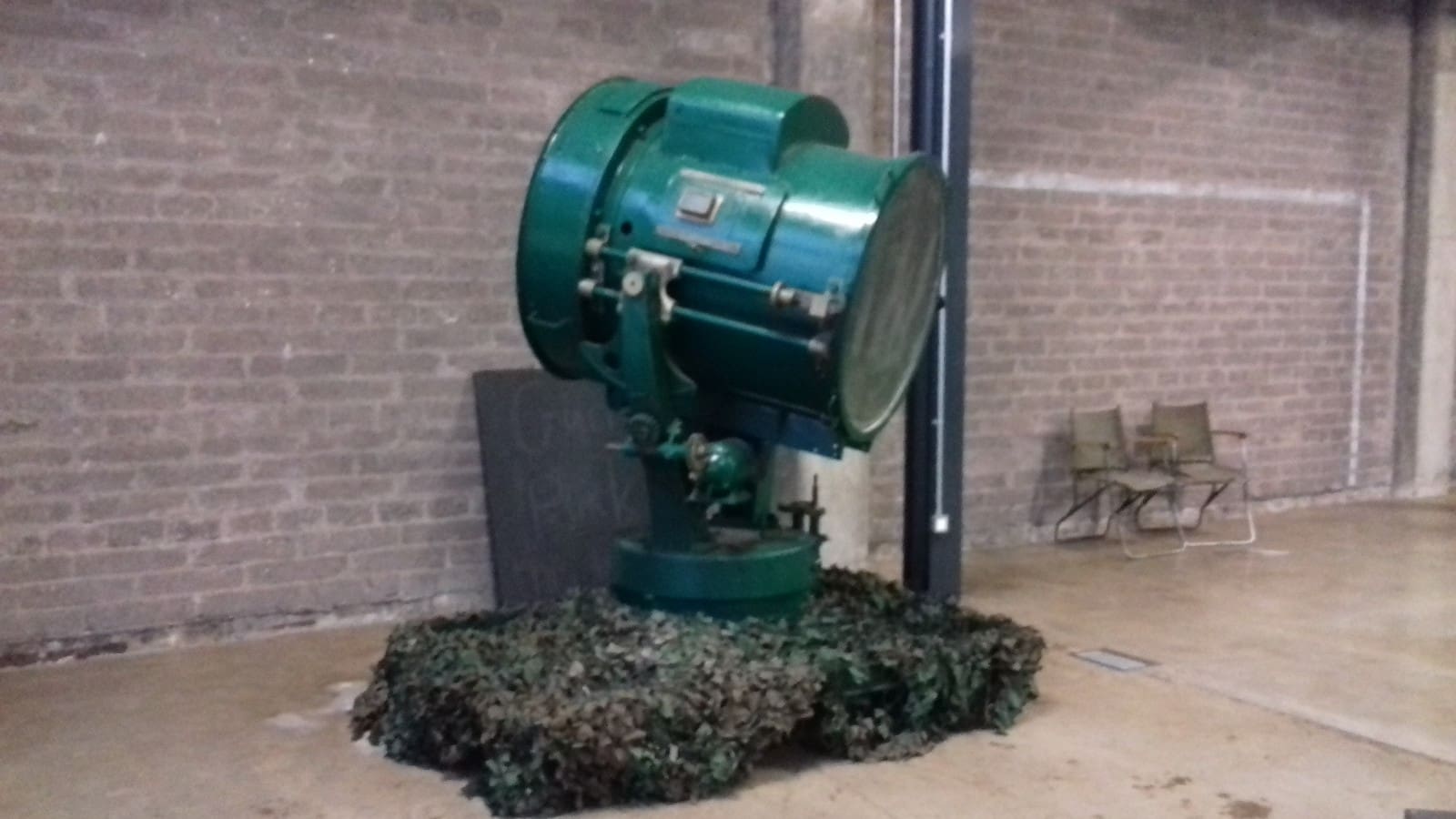 Manufacturer: Siemens, London, England
Manufacturer: Siemens, London, England
Dates in Irish Service: 1938-1947
This searchlight was manufactured in 1898 by Siemens of London. It emitted a light beam equivalent to two billion candles and had a range of 3,650 metres. The light from the burning of two carbon rods was concentrated and focussed by a highly polished mirror. The three searchlights on Spike Island and the two at Fort Davis were controlled from the Battery Observation Post on Spike Island to ensure that they operated in tandem with the guns. This enabled the 6-inch guns to operate at night.
Bofors 40mm/L60 Anti-Aircraft Gun
 Calibre 1.6 inch (40mm)
Calibre 1.6 inch (40mm)
Effective Range: 3,500 yards (3,200m)
Max Rate of Fire: 120 rounds per minute
Max speed of Target: 500 mph (804 kph)
Manufacturer: AB Bofors, Sweden.
Dates in Irish service: 1939 – 2001
This gun was made for air defence, ground and naval use and both had a calibre of 40mm and a barrel length of 60 x the calibre hence L60. Spike Island was the first location outside Dublin, where anti-aircraft guns were deployed by the Defence Forces during the Emergency (Second World War). The Reserve Coast Defence Artillery unit on Spike Island was reconstituted in 1979 as an anti-aircraft battery and the gun displayed here was part of its inventory.
Bofors 40mm/L70 Anti-Aircraft Gun and Fly Catcher Radar
 Calibre 1.6 inch (40mm)
Calibre 1.6 inch (40mm)
Effective Range: 3,500 yards (3,200m)
Max Rate of Fire: 120 rounds per minute
Max speed of Target: 500 mph (804 kph)
Manufacturer: AB Bofors, Sweden.
Dates in Irish service: 1939 – 2001
By the end of the Second World War, jet aircraft had so increased the speed of attack that the L60 could not get enough rounds into the air to effectively enagage the aircraft before it had flown out of range. The Bofors 40mm/L70 is an up-rated version of the L60 and this new weapon was now capable of electrically controlled automatic fire.
The “Fly Catcher” radar system was a self contained all weather integrated search radar and fire control system. It could track up to sixteen aircraft simultaneously within a range of up to twenty kilometres. The radar provided accurate targeting information to its accompanying battery of six L70 guns each of which could be deployed up to two kilometres from the radar.
The “Fly Catcher” was acquired from the Royal Netherlands Air Force in 2001 and last used in 2011.
Leyland Retriever, Machinery Lorry
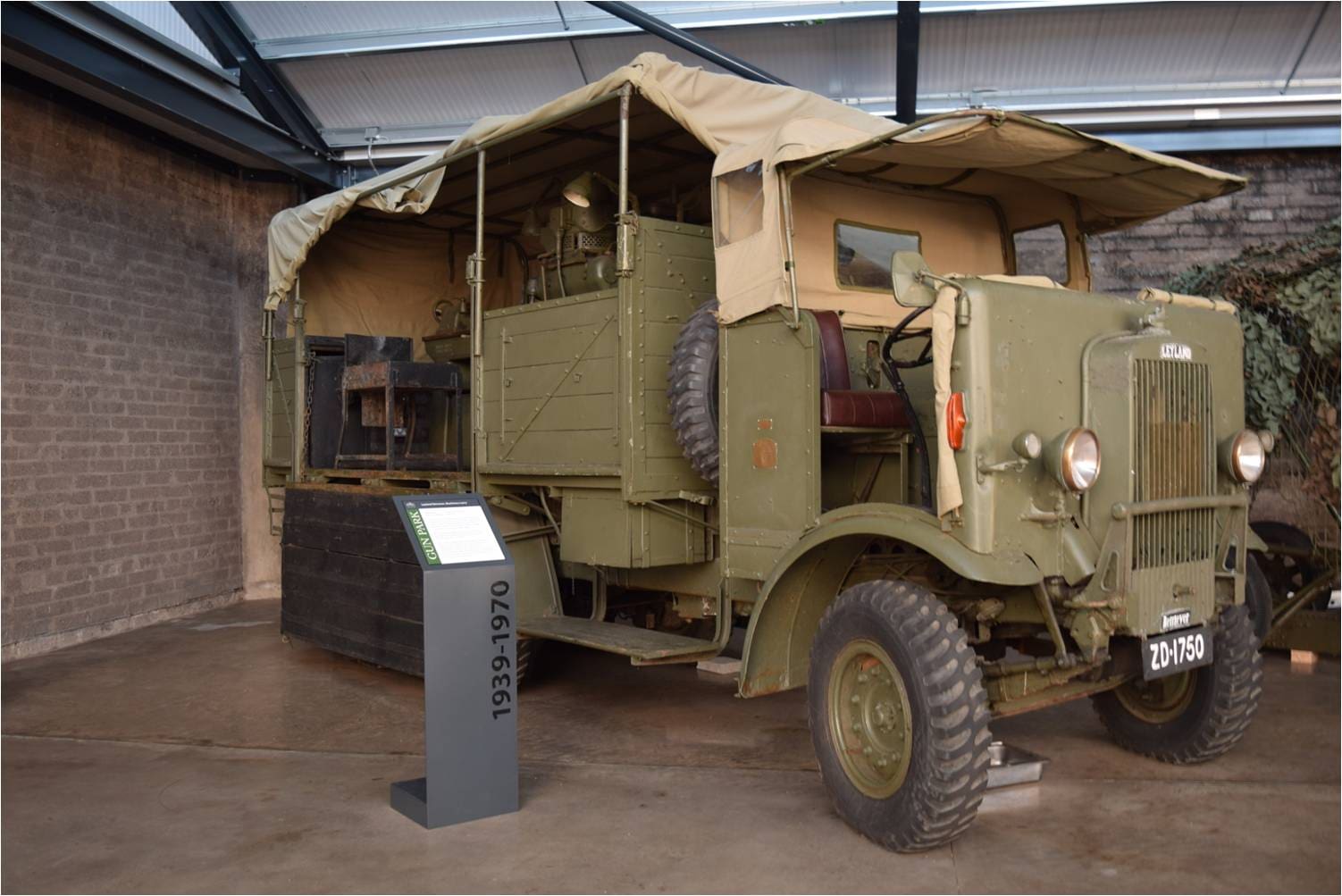 Manufacturer: Leyland Motors, England from 1939 -1945
Manufacturer: Leyland Motors, England from 1939 -1945
Weight: 7.7 tons
Speed: 30 mph (48 kph)
Drive: 6-wheeled, 4-wheel drive
Petrol Engine: 6 litre 4 cylinder, 73 brake horsepower (bhp)
Dates in Irish service: 1939 – 1970
The lorry that is displayed here was purchased in 1939 by the Defence Forces at a cost of £1,312. Its purpose was to carry out maintenance and repairs in the field with the Ordnance Corps in the Southern Command. The lorry is fitted with a lathe, pedestal drill, portable forge and grinder. The lorry has its own generator and could also use an external electricity supply.
17-pounder Anti-Tank Gun
 Calibre: 3-inch (76.2mm)
Calibre: 3-inch (76.2mm)
Effective Range: Up to 10,000 yards (9,114m)
Manufacturer: Royal Ordnance Factories
Dates in Irish service: 1949 – 1962
Developed in World War Two to counter new and heavily armoured German tanks, the 17 Pounder proved a battlefield success, variants serving both as a towed artillery piece and a tank-mounted main gun on allied tanks such as the Sherman Firefly. The only Allied tank capable of defeating the feared German Tiger and Panther tanks during the battle for Normandy. The 17 Pounder could also be flown into battle by a heavy glider. The Irish Army used the 17 Pounder from 1949 to 1962.
The QF 17 pounder’s special armour piercing shells were capable of penetrating 130mm of sloped armour at almost 1000 meters. Requiring a crew of at least seven men, the 17 pounder outperformed all other Allied anti-tank guns from 1943. QF 17 Pounder anti-tank guns were the most powerful guns ever employed by the Defence Forces.
25-pounder Field Artillery Gun
 Calibre: 3.45-inch (87.6 mm)
Calibre: 3.45-inch (87.6 mm)
Range: up to 13,123 yards (12,000 metres)
Manufacturer: Royal Ordnance Factories
Dates in Service: 1949 – 2009
During the 1930s, the 18-pounder was replaced by the 25-pounder. This larger gun became the standard field gun of the British artillery forces during and after the Second World War. A quantity of 25 pdr guns was purchased by the Irish Defence Forces in 1949 and became the mainstay of the Artillery Corps until replaced by the Air Deployable 105mm Light Artillery gun in 1980. The 25-pounder remained in service with the Reserve Defence Forces until 2009 and is now used only for ceremonial purposes.
Brandt 120 mm Mortar
 Manufacturer: Societe Nouvelle des Establisséménts, Brandt, Paris.
Manufacturer: Societe Nouvelle des Establisséménts, Brandt, Paris.
Calibre: 4.72” (120mm)
Ammunition types: High explosive, smoke and illumination
Range: up to 7,376 yards (6,745 m)
Dates in Irish service: 1953 – 2004
This mortar served with the Heavy Mortar Batteries in all the Irish Army Field Artillery Regiments. Troops equipped with this weapon were deployed to the Congo, Cyprus and Lebanon where they provided illumination fire missions in support of UN operations. The 120 mortar was mounted on an integral wheeled carriage that was normally towed by a Land Rover or Nissan Patrol.
Bofors 90mm Recoilless Anti-Tank Gun
 Manufacturer: Bofors, Sweden
Manufacturer: Bofors, Sweden
Weight: 260 Kg (573 lbs) with carriage
Sighting: Open, telescopic and 7.62mm ranging weapon
Ammunition types: Anti-tank and anti-personnel and training rounds
Range: 1,000m (1,120 yards)
Dates in Irish service: 1960 – 1990
The 90 mm anti-tank gun was capable of being man handled across rough terrain into a firing position by its five man crew. It was a very effective anti-tank weapon, however, the dramatic back blast from the gun quickly gave away its position to the enemy resulting in heavy counter fire.
Bofors 40mm/L60 Naval Gun
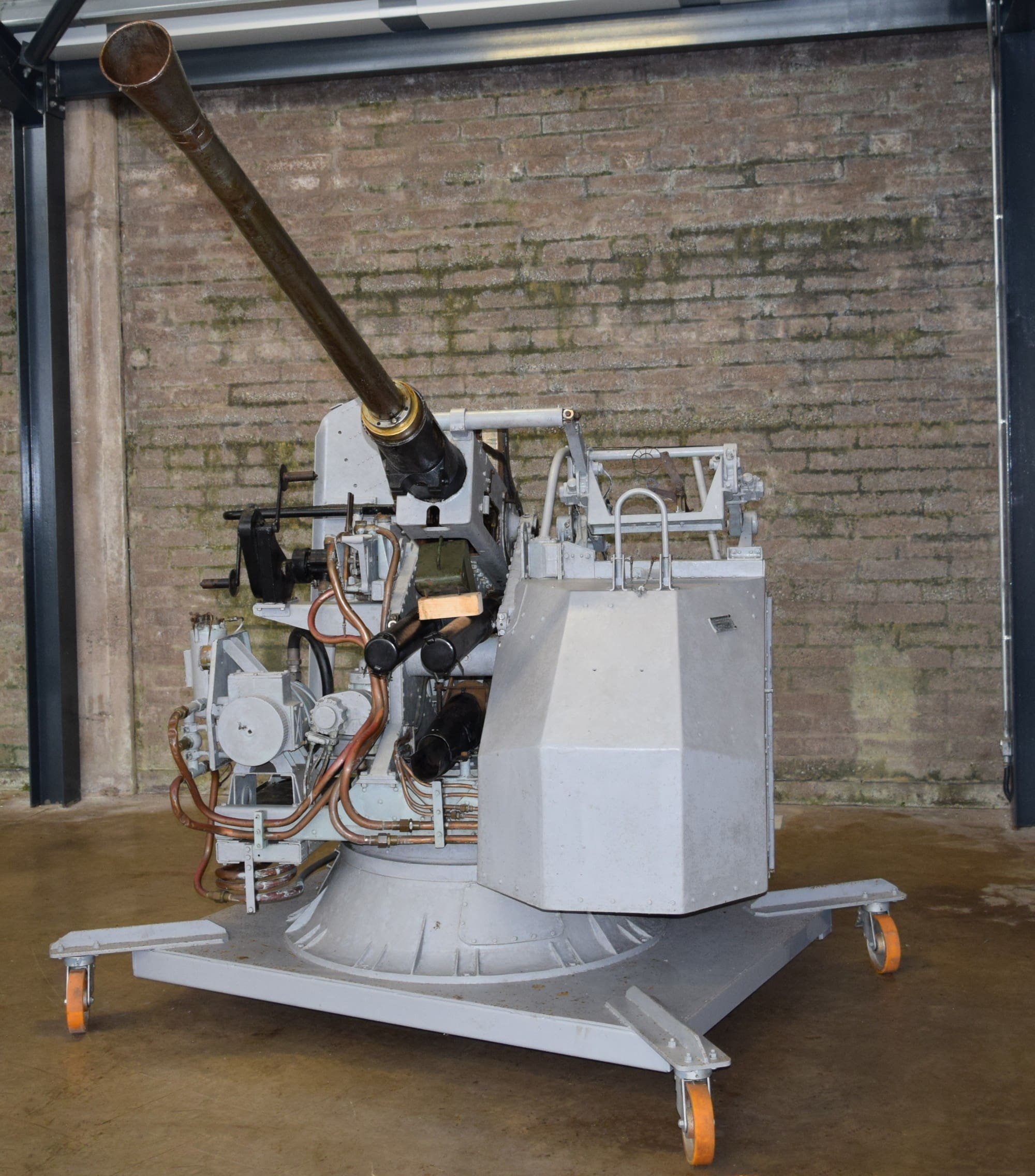 Calibre: 1.6 inch (40mm)
Calibre: 1.6 inch (40mm)
Effective Range: 3,500 yards (3,200m)
Manufacturer: AB Bofors, Sweden
Dates in Irish Naval Service use: 1970 – 2004
This L60 gun was considered to be the most successful anti-aircraft weapon of the Second World War. From 1970 to 2004 this was the main armament on several Irish Naval Service vessels until replaced by the L 70 on a phased basis beginning in 2003. A hydraulic system was used to aim the L 60 and it could also be operated manually. Some were later converted to operate electrically. While the naval L 60 was very similar to its land-based counterpart its special mounting and hydraulic power made it a formidable weapon in both anti-aircraft and anti-surface roles.
4.5″ Howitzer

The Ordnance QF 4.5-inch howitzer was the standard British Empire field (or “light”) howitzer of the First World War era. It replaced the BL 5-inch howitzer and equipped some 25% of the field artillery. It entered service in 1910 and remained in service through the interwar period and was last used in the field by British forces in early 1942. It was generally horse drawn until mechanisation in the 1930s.
The QF 4.5-inch (110 mm) howitzer was used by British and Commonwealth forces in most theatres, by Russia and by British troops in Russia in 1919. Its calibre (114 mm) and hence shell weight were greater than those of the equivalent German field howitzer (105 mm); France did not have an equivalent. In the Second World War it equipped some units of the British Expeditionary Force in France and British, Australian, New Zealand and South African batteries in East Africa and the Middle East and Far East.
Proving Mortar
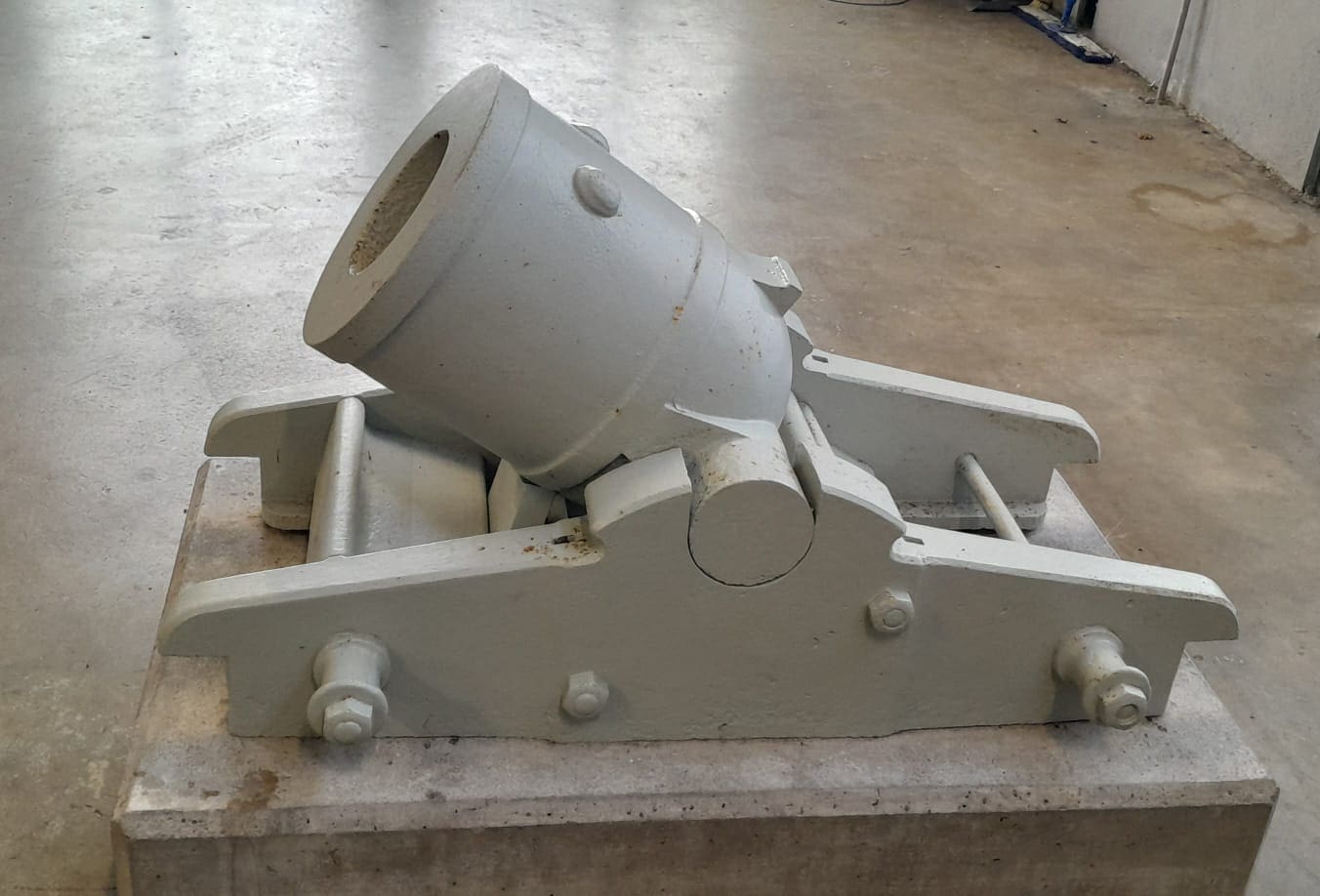 Proving Mortar
Proving Mortar
Scorpion – Combat Vehicle Reconnaissance Tracked, CVR(T)
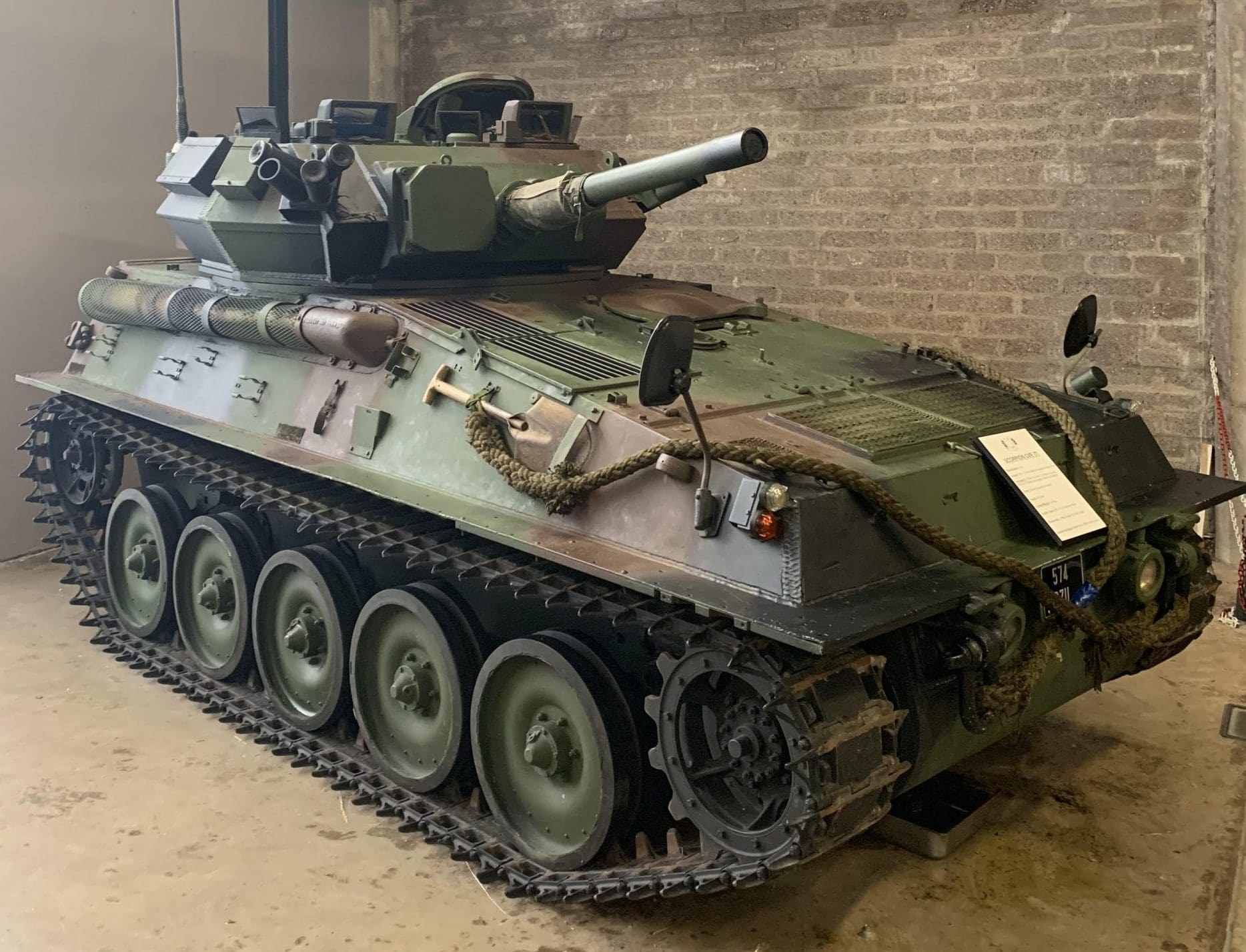 Manufacturer: Alvis, Coventry, England
Manufacturer: Alvis, Coventry, England
Armament: 76mm cannon, 7.62mm co-axial machine gun 0.5-inch HMG and 4 x smoke dischargers
Main Gun: Fired anti-tank, high explosive, smoke and illumination rounds
Armour: 14.5 – 12.7mm welded aluminium armour plate
Crew: Commander, gunner and driver
Speed / Range: 80.5 KPH, 644 Km road, 390 KM cross country
Engine: Jaguar J 60, 4.2 Lt six-cylinder petrol
Dates in Irish service: 1980 – 2016
The Scorpion, Combat Vehicle Reconnaissance Tracked, CVR(T) gave the Defence Forces an armoured tracked vehicle that provide firepower, reconnaissance, protection and mobility with an enhanced cross country capability.
PANHARD AML 90
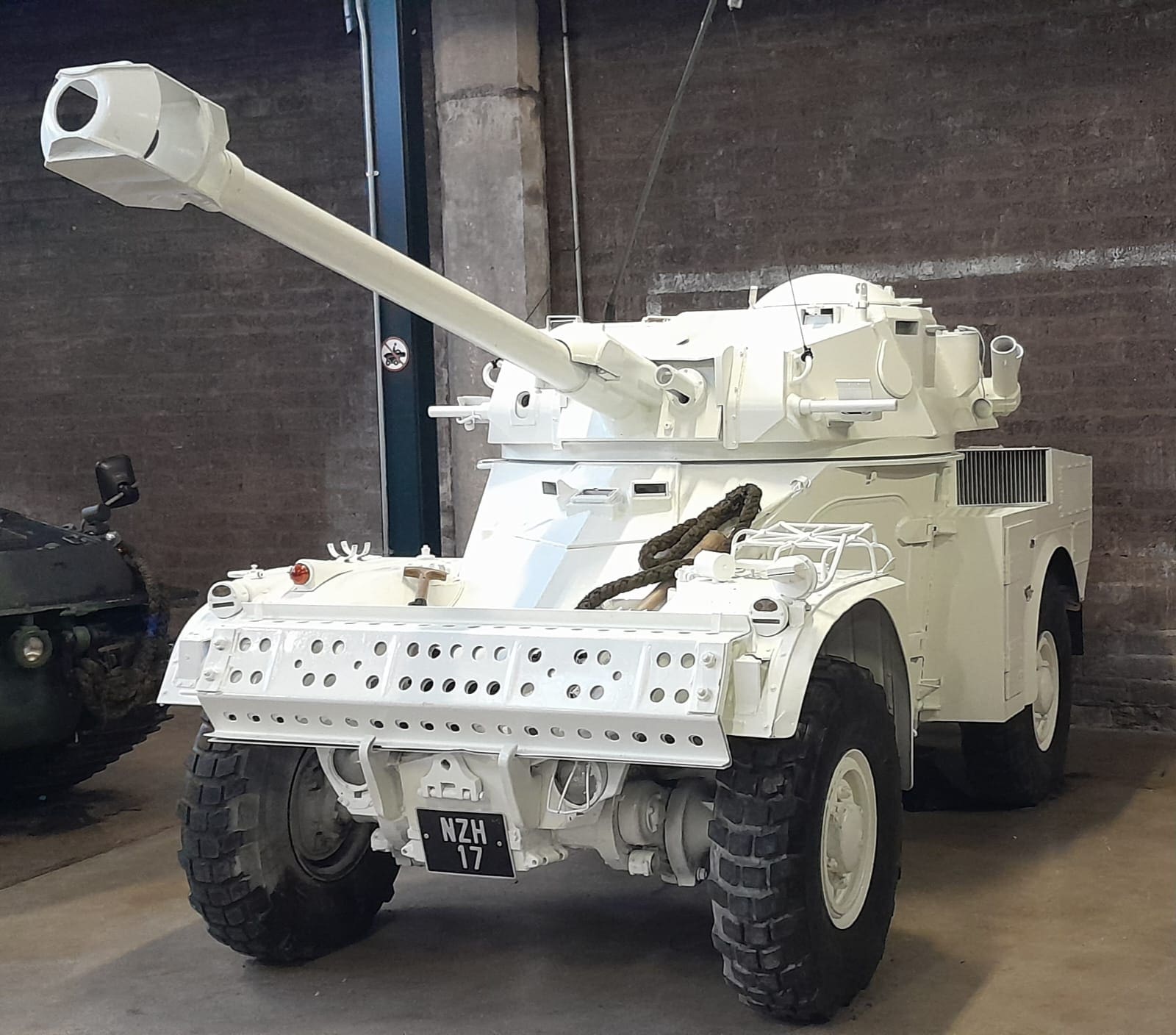 AML-90 was designed for carrying out rearguard duties and substituting for the heavier tanks and armoured fighting vehicles deployed in a more linear fashion at the front. Its major feature was its DEFA low-pressure 90 mm rifled gun, which permitted the anti-tank and reconnaissance elements. It was specifically designed for vehicles weighing under ten tonnes in mind, and the successful mating of such a large calibre weapon on the five-tonne AML chassis was then considered a major engineering achievement. This made an AML-90 exceptionally well-armed in proportion to its weight, and offered the advantage of easier recoil loads over conventional tank cannon.
AML-90 was designed for carrying out rearguard duties and substituting for the heavier tanks and armoured fighting vehicles deployed in a more linear fashion at the front. Its major feature was its DEFA low-pressure 90 mm rifled gun, which permitted the anti-tank and reconnaissance elements. It was specifically designed for vehicles weighing under ten tonnes in mind, and the successful mating of such a large calibre weapon on the five-tonne AML chassis was then considered a major engineering achievement. This made an AML-90 exceptionally well-armed in proportion to its weight, and offered the advantage of easier recoil loads over conventional tank cannon.
6” MK VII BREECH-LOADING GUN
 The 6-inch guns entered British service at the start of the 20th Century and saw use in naval, coastal and land artillery roles. Three of these guns were located on Spike Island from circa 1902. Two were mounted operationally in open emplacements on Number 3 Bastion and the third for training purposes in the Drill Shed. In 1938, the Irish Army’s Coastal Defence Artillery took over Spike Island’s 6” guns. In 1943 the two guns were relocated to their present underground emplacements under Numbers 2 and 4 Bastions. Spike Island’s 6” guns were manned continuously throughout the ‘Emergency’ period.
The 6-inch guns entered British service at the start of the 20th Century and saw use in naval, coastal and land artillery roles. Three of these guns were located on Spike Island from circa 1902. Two were mounted operationally in open emplacements on Number 3 Bastion and the third for training purposes in the Drill Shed. In 1938, the Irish Army’s Coastal Defence Artillery took over Spike Island’s 6” guns. In 1943 the two guns were relocated to their present underground emplacements under Numbers 2 and 4 Bastions. Spike Island’s 6” guns were manned continuously throughout the ‘Emergency’ period.
Post-war, the role of Coastal Defence declined, with eventual disbandment and re-rolling to air defence artillery. Spike Island’s 6” gun on Bastion 2 saw a new lease of life with the arrival of the Prison Service in 1985, with staff and inmates working on its restoration, a task which was taken up by a team of ex-island residents and volunteers in the years after the prison closed. Today both guns 1 and 2 are open to the public and are kept in a high state of restoration, and continue to impress the visiting public. The 6” guns are the largest surviving examples of breech-loading guns in Ireland.

